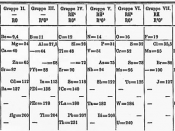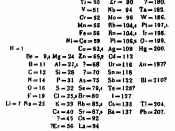The Periodic Tablea)i)name of the element: oxygenii) Symbol: Oiii) Atomic number: 8iv) Mass number: 15.9994 amuv) Number of neutrons: 8vi) Electron configuration:vii) Appearance:viii) Melting point: -218.4ðC boiling point: -183.0ðCix) Density: 1.429g/cmóx) Valencies:2xi) Uses of the element: without oxygen, there would be no life on this earth because oxygen is one of the necessities for life on this planet.
xii) Brief outline of its discovery: it was discovered in 1774 by Joseph Priestly. It was obtained from liquid air. The name comes from the Greek words 'oxus' which means acid, and 'gennen' which means generate.
b) Briefly outline the development of the periodic table focusing on the contributions made by Mendeleev.
The periodic table is a very important source of information for many around the world for it is the organisation of all of the known elements. The table is very useful because it is easy to read information from once you are able to understand how it is arranged.
Long ago, there was no need for the periodic table for they did not understand the world around them. Though when phosphorus was discovered by Hennig Brand, from preparing it from urine, an immense amount of information about compounds and elements were discovered during the time after that. When more and more elements and compounds were being discovered, scientists found the need to organise that information of easy access and use for future use. To organise the information they had collected they found patterns which was found throughout their discoveries as a foundation to arrange them.
Johann Dobereiner was a German chemist who was one of the first to make an attempt to organise the elements. He attempted to organise them by looking at both physical and chemical properties. In 1817 Johann Dobreniner was able to find a remarkable pattern that...



...
To tell u the truth I really thought this essay was boring and I didn't get it at all...
0 out of 1 people found this comment useful.